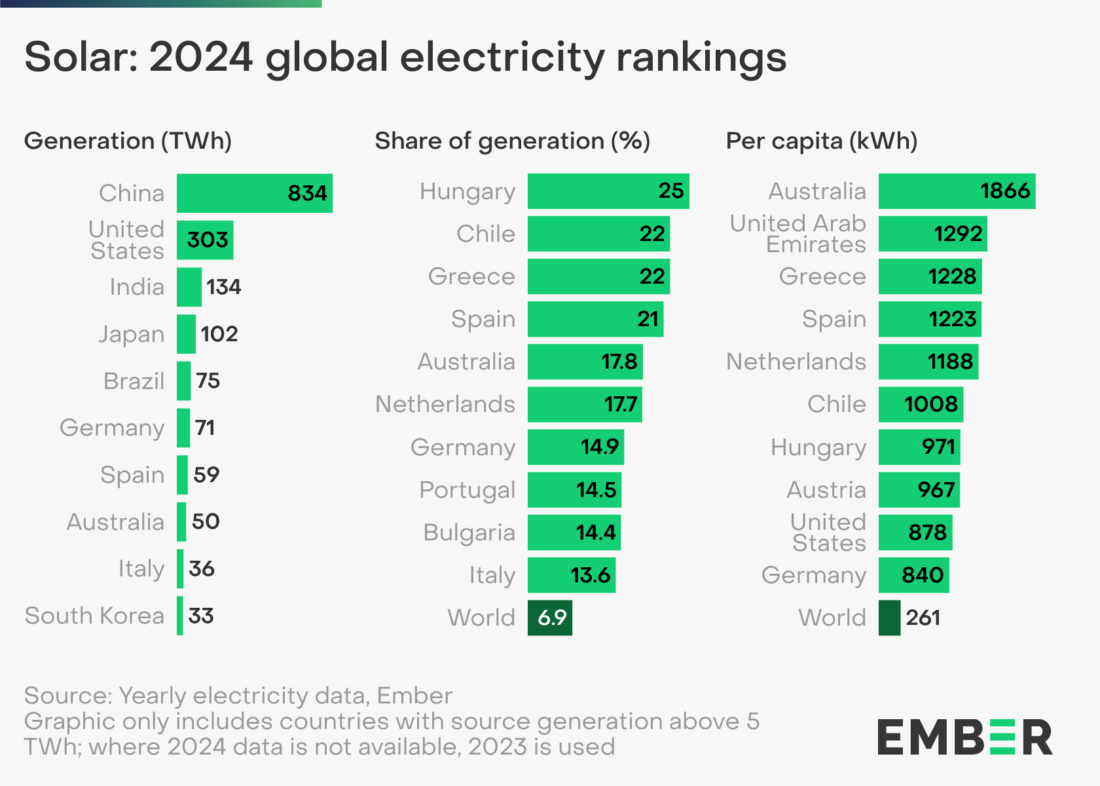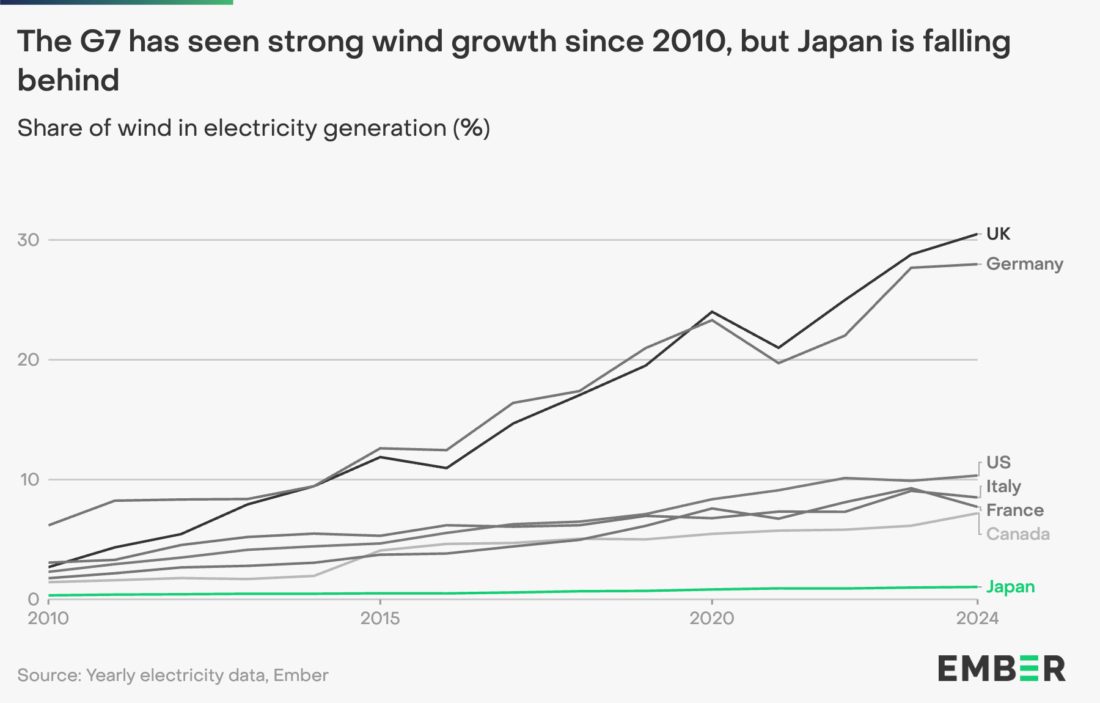On April 8, 2025, global energy think tank Ember released the report “Global Electricity Review 2025,” an annual comprehensive overview of changes in global electricity generation based on analysis of data from 215 countries. The report found that non-fossil energy sources provided 40.9% of the world’s energy in 2024, driven by record growth in renewables led by solar. In comparison, Japan generated 31.5% of its electricity from non-fossil sources and 23.2 % from renewables in 2024, both below the global average.
*In the report, Ember uses the terms “clean” or “low-carbon” power sources to refer to non-fossil energy sources (renewables plus nuclear).
Solar power leads growth in clean energy
Globally, renewable power sources added a record 858 TWh of generation in 2024, 49% more than the previous record of 577 TWh set in 2022. Solar was the largest contributor for the third year running, adding 474 TWh to reach a share of 6.9%. Solar was the fastest-growing power source (+29%) for the 20th year in a row, and has doubled in just three years, providing more than 2,000 TWh of electricity in 2024.
More than half (53%) of the increase in solar generation in 2024 was in China, with China’s clean generation growth meeting 81% of its demand increase in 2024. The fast pace of global solar growth is set to continue, with 2024 setting a new record for solar capacity installations in a single year – more than double the amount installed in 2022. Global solar power capacity reached 1 TW in 2022 after decades of growth, but reached 2 TW only two years later, in 2024.
Solar is Japan’s largest source of low-carbon electricity. Its share has grown fivefold from 2014 to reach 10% of generation in 2024. Japan remained the world’s fourth largest solar generator.

Hydro remained the largest source of low-carbon electricity (14.3%), followed by nuclear (9.0%), with wind (8.1%) and solar (6.9%) rapidly gaining ground and together overtaking hydro in 2024, while nuclear’s share reached a 45-year low.
Wind is the world’s second-largest growing source of electricity after solar. However, Japan only generated 1% of its electricity from wind in 2024. This is in stark contrast to the rest of the G7, where wind has risen to an average of 12% of total electricity generation. As a result, solar (10%), Japan’s largest source of clean electricity, and wind (1%) combined totaled only 11% in 2024, below both the global average (15%) and regional average (14%).

Hotter weather led to increased greenhouse gas emissions
Ember’s analysis found that, despite the rise in renewables, fossil generation saw a small 1.4% increase in 2024 due to surging electricity demand, pushing global power sector emissions up 1.6% to an all-time high of 14.6 billion tonnes of CO2.
Heatwaves were the main driver of the rise in fossil generation, accounting for almost a fifth (+0.7%, +208 TWh) of the increase in global electricity demand in 2024 (+4.0%), mainly through additional use of cooling. Without these hotter temperatures, fossil generation would have risen by only 0.2%, as clean electricity generation met 96% of the demand growth not caused by heatwaves. The increase in global fossil generation in 2024 (+245 TWh) was virtually identical to that seen in 2023 (+246 TWh) despite the substantial difference in rates of demand growth.
Clean energy growth is set to outpace increased demand
Aside from weather effects, increased use of electricity for AI, data centres, electric vehicles and heat pumps is already contributing to global demand growth. Combined, growing use of these technologies accounted for a 0.7% increase in global electricity demand in 2024, double what they contributed five years ago.
The report shows that clean generation growth is set to outpace faster-rising demand in the coming years, marking the start of a permanent decline in fossil generation. The current expected growth in clean generation would be sufficient to meet a demand increase of 4.1% per year to 2030, which is above expectations for demand growth.
Japan is already in an era of fossil decline. Fossil demand in the power sector peaked in 2012 and has declined by 28% since then. In 2024, Japan’s power demand increased by 9 TWh (+0.9%), in part as a result of hotter temperatures in summer months. However, clean sources grew more than twice as much (+ 21 TWh).
Aditya Lolla, Ember’s Asia Programme Director, spoke on the outlook of renewable energy in Asia: “Asia’s clean energy transition is picking up speed, driven by record growth in solar and other renewables. With electricity demand set to rise across the region, a robust clean energy market is crucial for the continued expansion of clean power. This will not only strengthen energy security and economic resilience, but also help emerging countries access the benefits of a new clean energy market economy.”
Commenting on Japan, Lolla said “Japan has made progress in expanding solar power. While the recent plan to expand renewables by 2040 is positive, a low NDC target risks putting the country behind other developed nations in the energy transition.”
Report Download
Global Electricity Review 2025(Link)
Related Pages
[Ember] Country Overview: Japan
[Ember] Electricity Data Explorer
Written/Published by: Ember
Published: April 8, 2025
